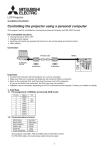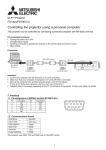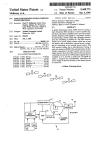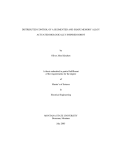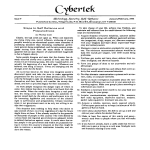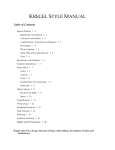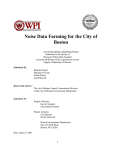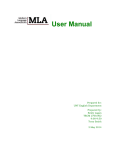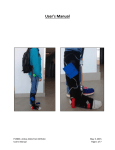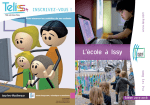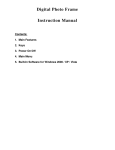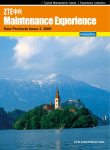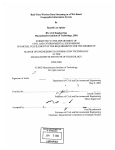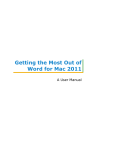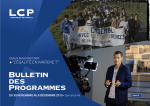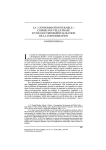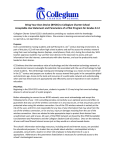Download C&E Soc 140: Introduction to Community and Environmental
Transcript
Soc/CESoc 140: Introduction to Community & Environmental Sociology Instructor: Yifei Li Office: 308E Agricultural Hall Email: [email protected] Classroom: 10 Agricultural Hall Class Time: Tuesday/Thursday 1:00-2:15pm Office Hours: Tuesday/Thursday 11am-12pm Overview In this course, we will examine the linkages between people and places, the local and the global, as well as the social and the natural. The course is divided into three sections. In the first section, we will explore changes in local communities. We will center our discussion on the concept of “place,” and how social processes are deeply “emplaced.” The second part of the course examines global communities, and how the global and the local are inter-connected through the movement of stuff and people. In the third section, we will spend time interrogating the ecological community, or “community in the largest possible sense” (Bell, 2012:2). We will think about how the social and the natural are linked to each other. This course offers an introduction to sociological theories that explain changes in the community and our relationships to the natural environment. By the end of the semester, you will gain deeper understandings of a set of concepts, including community, social capital, development, globalization, consumption, nature, sustainability, risk, and social construction. Sociological theories and concepts are not absolute truth; virtually every issue can be explored from more than one perspective. While each of these alternative points of view has shortcomings, each can generate useful insights. We will use sociological theories to critically understand some of the pressing social and environmental issues. Required Textbooks • McKibben, B. (2007). Deep economy: The wealth of communities and the durable future. New York: Times Books. • Bell, M. (2012). An invitation to environmental sociology. Fourth Edition. Thousand Oaks, Calif: Pine Forge Press These books are available at the University Bookstore. If you decide to buy online, make sure you order the correct edition. If you do not wish to buy these books, you may read them in the library. Both books are on reserve at Steenbock Library. Additional copies of the McKibben book are on reserve at College Library. Additional readings are available on Learn@UW at learnuw.wisc.edu. Fall 2013 1/9 Soc/CESoc 140 Course Requirements • Response papers (50*4=200 points) You have the opportunity to write five response papers over the course of the semester. The four highest scores will be recorded. Each paper is worth 50 points for a total of 200 points. Response papers are due before class on 9/19, 10/1, 10/17, 11/5, and 11/21. You are required to turn in a word file of your paper to Turnitin.com (the class ID is 6502259, and passcode is cesoc), as well as a hard copy before the start of class. If you are not familiar with Turnitin.com, please refer to Appendix 1. Please limit each response paper to one page, with one-inch margins, single-spaced. If you cite materials not on this syllabus, please include a bibliography, on a separate page, acknowledging your sources properly. Make sure you follow the grading rubric as you write. If you are unsatisfied with your score, there is an opportunity to rewrite. Re-writes must be turned in within a week after grades are posted on Learn@UW. The UW Writing Center (http://www.writing.wisc.edu/, 608-263-1992) is a resourceful place that can help you become better writers. You may schedule one-on-one sessions with writing experts. There are many writing workshops throughout the semester. • Revised and expanded response paper (150*1=150 points) You are required to revise and expand one of your response papers. Choose your favorite response paper and do a modest amount of additional research and reading. See handout for details. Expand, improve, and clarify your argument. Polish your writing and turn in an expanded version. This assignment is worth 150 points. It is due 3pm on Monday December 16, 2013. NO LATE PAPERS OR RE-WRITES for this assignment. You are required to turn in a word file of your paper to Turnitin.com, and to deposit a hard copy of your paper to the collection box on the Third Floor of Agricultural Hall. Please limit your writing for this assignment to three pages, with one-inch margins, single spaced. • Exams (200*3=600 points) Each of the three exams will consist of multiple choice questions, and possibly short answer questions. The exams will cover lectures, class discussions, readings, and films. Exams are non-cumulative. Each exam will be worth 200 points. Exams will be given during class time on 10/3, 11/7 and 12/12. • Preparation/Attendance/Participation (a total of 50 points) Attending lectures and discussions is critical to your success in this class. I will use different means to check attendance, including but not limited to (a) pop quizzes at the beginning of class to test your mastery of readings assigned for the day, (b) pop quizzes at the end of class to test your understanding of the lecture, (c) opinion surveys of the class. Attendance checks are unscheduled. The worth of each attendance check will be announced before it is taken. They will add up to 50 points. In accordance with UW policy, students will not lose attendance points when they are absent from class to observe religious holidays. Fall 2013 2/9 Soc/CESoc 140 Late Policy If you submit your response paper after the due date, your score will be penalized by 10% for each day after the due date. You are required to turn in both hard copies and electronic copies of paper assignments before they are due. Requests for extension may not be approved. Exam Policy Make-up exams will be given only if you provide the instructor, in writing, an acceptable excuse from an accredited professional regarding the situation. You should submit the written notice in person before the scheduled exam. Make-up exams will be scheduled at a time that is convenient for all students that miss the exam, but no later than two weeks after the scheduled exam. No retakes will be given for students who are dissatisfied with their exam scores. Grading Scale A=94% or more C=70-76.9% AB=88-93.9% D=60-69.9% B=83-87.9% F=59.9% or less BC=77-82.9% Office Hours Office hours are 11am -12 pm on Tuesdays and Thursdays. My office is Room 308E in Agricultural Hall. Office hours will NOT be devoted to tutorial for materials that students miss when not attending class. Lecture Slides I will post lecture slides on Learn@UW after each class. These slides alone do not provide a sufficient basis for you to answer exam questions. They are meant to provide a general outline. Readings It is extremely important for you to keep up with the required readings for each session. I lecture with the assumption that you have read all pieces before class. I normally do not lecture from the readings, but try to build on them. In order for you to benefit from lectures, it is best to read the assignments in advance. You may also bring along your questions about specific readings to class. Communication I will make an effort to timely announce any changes to the syllabus via email, on Learn@UW, and in class. Please make sure you check your wisc.edu emails, and let me know if you have trouble receiving emails sent to the class list. You are welcome to communicate with me via email. When you do so, make sure the subject line of your email begins with “140.” Please expect a reply within 48 hours. However, I will NOT respond to questions whose answers are contained in this syllabus. Nor will I respond to questions that have been addressed in class. Try to ask questions of clarification in class so your fellow classmates can also benefit from the exchange. Fall 2013 3/9 Soc/CESoc 140 Academic Honesty All work that you submit for this class must be your own. All sources and assistance used in preparing your papers must be precisely and explicitly acknowledged. Please read Appendix 2 if you need more information about this. If you are still unsure, come and talk with me, or consult the Writing Center (http://www.writing.wisc.edu/, 608-263-1992). Cheating on exams and response papers will not be tolerated. Students caught completing quizzes for students not attending the session will be charged with academic misconduct. Students caught cheating will receive a grade of F for the entire course, and the case will be reported to the Dean of Students. NO EXCEPTIONS. You should familiarize yourself with UW rules regarding academic honesty at http://students.wisc.edu/doso/acadintegrity.html. Classroom Etiquettes One of my responsibilities is to ensure that the environment in the classroom is conducive to learning. If you are late, you should find a seat in the back of the classroom. If you need to leave early, please let me know in advance and sit in a location where it will be easy to quietly leave the room. Turn off all cell phones and put away newspapers before class begins. Please hold sideconversations and discussions until after class. Although computers are a valuable tool for research and study, they are inimical to participation and collegiality in the classroom. The use of laptops or other electronic devices for note-taking or other purposes in class, therefore, will NOT be permitted. Accommodation I wish to include fully any students with special needs in this course. Please let me know (the earlier the better) if you need any special accommodations in the curriculum, instruction, or evaluation procedures in order to enable you to participate fully. The McBurney Center (www.mcburney.wisc.edu, 702 W. Johnson Street, 608-263-2741) can provide useful assistance and documentation. If English is not your first language, or one of your first languages, you may have an additional fifteen (15) minutes for each exam. To take advantage of this, please come and talk with me at your earliest convenience. Nighttime Safety The University has established several transportation and walking escort services to help you stay safe while getting around campus and the nearby areas after dark. To help take responsibility for your own safety and that of your friends, make use of services such as SAFEwalk and SAFEride. Details can be found at http://transportation.wisc.edu/transportation/safeservices.aspx Fall 2013 4/9 Soc/CESoc 140 Class Schedule and Reading Assignments Local Community: Growth and Prosperity in Places Week 1 – Community • September 3 Read the opening paragraphs of this syllabus, if you have not done so already. • September 5 McKibben, B. (2007). Deep economy: The wealth of communities and the durable future. New York: Times Books, Introduction and Ch. 1: After growth. Week 2 – Growth Machine • September 10 Bell, M. (2012). An invitation to environmental sociology. Thousand Oaks, Calif: Pine Forge Press, Ch. 3: Money and Machines. • September 12 Logan, J. R., & Molotch, H. L. (2007). Urban fortunes: The political economy of place. Berkeley, CA: University of California Press, Ch. 3: The city as a growth machine. Week 3 – Social Capital • September 17 Putnam, R. D. (2000). Bowling alone: The collapse and revival of American community. New York: Simon & Schuster, Ch. 1: Thinking about social change in America. McKibben, B. (2007). Deep economy: The wealth of communities and the durable future. New York: Times Books, Ch. 3: All for one, or one for all. • September 19 Response Paper #1 – What are some of the defining characteristics of the growth machine? Pick DUE two characteristics of the growth machine, elaborate. Find a concrete example (in the news or from your own knowledge) that may support the theory, prove it wrong, or lend partial support. Explain. Hart-Brinson, P. (January 01, 2011). New Ways of Bowling Together? Contexts, 10, 4, 28-33. Putnam, R. D., Feldstein, L. M., & Cohen, D. (2003). Better together: Restoring the American community. New York: Simon & Schuster, Conclusion: Making Social Capital Work. Fall 2013 5/9 Soc/CESoc 140 Week 4 – Rethinking Community • September 24 (Class meets in Room 3218, Sewell Social Science Building.) McKibben, B. (2007). Deep economy: The wealth of communities and the durable future. New York: Times Books, Ch. 4: The wealth of communities. • September 26 Bellah, R. N. (1996). Habits of the heart: Individualism and commitment in American life. Berkeley: University of California Press, Ch. 7: Getting involved. Mills, C. W. (1959). The sociological imagination. Oxford, England: Oxford University Press, Ch. 1: The promise. Week 5 – Case Study: Wal-mart • October 1 Response Paper #2 – Analyze your own Facebook network. Explain the forms of social capital in DUE your network. If you are not a Facebook user, or if you prefer not to work with your Facebook network, you should speak with me as soon as possible to make alternative arrangements. Moreton, B. E., (2006) It came from Bentonville: The agrarian origins of Wal-Mart culture, in Lichtenstein, N. (eds). Wal-Mart: The face of twenty-first-century capitalism. New York: New Press, pp. 57-82. Goetz, S. J., & Swaminathan, H. (June 01, 2006). Wal-Mart and County-Wide Poverty. Social Science Quarterly, 87, 2, 211-226. In-class documentary: Wal*Mart: The high cost of low price. • October 3 (Exam #1) Global Community: Inequality and Justice in International Development Week 6 – Development in Theory • October 8 Sen, A. (1999). Development as freedom. New York: Knopf, Ch. 2: The ends and means of development. Giddens, A. (2000). Runaway world: How globalization is reshaping our lives. New York: Routledge, Ch. 5: Democracy. • October 10 Escobar, A. (1995). Encountering development: The making and unmaking of the Third World. Princeton, N.J: Princeton University Press, Ch. 2: The problematization of poverty. Gertner, J. (May 16, 2010). The rise and fall of the G.D.P. New York Times Magazine, 6064,66,68,70-71. Fall 2013 6/9 Soc/CESoc 140 Week 7 – Development in Practice • October 15 World Bank. (2013). Planning, connecting, and financing cities--now: Priorities for city leaders. Washington, DC: World Bank, pp. 1-39. • October 17 Response Paper #3 – How is development defined? Pick two definitions of development, compare DUE and contrast. You may focus your comparison on different goals, approaches, and guiding principles. Which definition best describes World Bank practices? Which definition do you like better? Why? Goldman, M. (2005). Imperial nature: The World Bank and struggles for social justice in the age of globalization. New Haven, Conn: Yale University Press, Ch. 3: Producing green science inside headquarters. Week 8 – Stuff on the Move • October 22 Bell, M. (2012). An invitation to environmental sociology. Thousand Oaks, Calif: Pine Forge Press, pp. 24-33, 137-145. Acaroglu, L. (May 4, 2013). Where Do Old Cellphones Go to Die?, New York Times. In-class documentary: 60 minutes: The electronic wasteland. • October 24 Guest speaker: John Chung-En Liu Readings TBA. Week 9 – People on the Move • October 29 (Class meets in Room 3218, Sewell Social Science Building.) Kasinitz, P. (2008). Inheriting the city: The children of immigrants come of age. New York: Russell Sage Foundation, Ch. 1: Introduction. Lee, J., & Bean, F. D. (2010). The diversity paradox: Immigration and the color line in twenty-first century America. New York: Russell Sage Foundation, Ch. 1: Introduction. • October 31 Harrison, J. L., & Lloyd, S. E. (March 01, 2012). Illegality at Work: Deportability and the Productive New Era of Immigration Enforcement. Antipode, 44, 2, 365-385. Harrison, J. L., & Lloyd, S. E. (August 01, 2013). New jobs, new workers, and new Inequalities: Explaining employers' roles in occupational segregation by nativity and race. Social Problems, 60, 3, 281-301. Fall 2013 7/9 Soc/CESoc 140 Week 10 – Commodity Chains • November 5 Response Paper #4 – What are the implications of immigration for the community? Locate the US DUE Census Bureau American FactFinder web tool. Pick a community you know well, such as your hometown. Find out how immigration has changed the demographics of the community. Guest speaker: Professor Jane Collins Collins, J. L. (2003). Threads: Gender, labor, and power in the global apparel industry. Chicago: University of Chicago Press, Ch. 2: The emergence of a twenty-first century apparel industry. • November 7 (Exam #2) Ecological Community: Interrogating Different Paths towards Sustainability Week 11 – Consumption • November 12 Bell, M. (2012). An invitation to environmental sociology. Thousand Oaks, Calif: Pine Forge Press, Ch. 2: Consumption and materialism. Maniates, M. (August 01, 2001). Individualization: Plant a Tree, Buy a Bike, Save the World?. Global Environmental Politics, 1, 3, 31-52. • November 14 Johnston, J., & Baumann, S. (2010). Foodies: Democracy and distinction in the gourmet foodscape. New York: Routledge, Ch. 4: Foodie politics. Week 12 – Conservation • November 19 Bell, M. (2012). An invitation to environmental sociology. Thousand Oaks, Calif: Pine Forge Press, Ch. 8: The human nature of nature. Brockington, D., Duffy, R., & Igoe, J. (2008). Nature unbound: Conservation, capitalism and the future of protected areas. London: Earthscan, Ch. 4: The power of parks. • November 21 DUE Fall 2013 Response Paper #5 – Interview two people about their perceptions of organic food, local food, and/or slow food. Pick one interviewee from the senior age group, and the other from the middle-aged group. Compare their views with that of yours. Be attentive to possible intergenerational differences. 8/9 Soc/CESoc 140 Giddens, A. (2000). Runaway world: How globalization is reshaping our lives. New York: Routledge, Ch. 2: Risk. Bell, M. (2012). An invitation to environmental sociology. Thousand Oaks, Calif: Pine Forge Press, Ch. 9: The rationality of risk. Weeks 13 & 14 – Green Economic Transformations • November 26 Roaf, S., Crichton, D., & Nicol, F. (2009). Adapting buildings and cities for climate change: A 21st century survival guide. Amsterdam: Elsevier, Ch. 9: The failure of “modern buildings.” In-class documentary: The greening of Southie. • December 3 Bell, M. (2012). An invitation to environmental sociology. Thousand Oaks, Calif: Pine Forge Press, Ch. 11: Governing the ecological society. Zehner, O. (2012). Green illusions: The dirty secrets of clean energy and the future of environmentalism. Lincoln: University of Nebraska Press, Ch. 1: Solar cells and other fairy tales. • December 5 Hess, D. J. (2012). Good green jobs in a global economy: Making and keeping new industries in the United States. Cambridge, Mass: MIT Press, Ch. 2: Green jobs and the green energy transition. Magdoff, F., & Foster, J. B. (2011). What every environmentalist needs to know about capitalism: A citizen's guide to capitalism and the environment. New York: Monthly Review Press, Ch. 5: Can capitalism go green?. Week 15 – Wrap-up • December 10 McKibben, B. (2007). Deep economy: The wealth of communities and the durable future. New York: Times Books, Ch. 5: The durable future. Schor, J. (2010). Plenitude: The new economics of true wealth. New York, N.Y: Penguin Press, pp. 1-7. • December 12 (Exam #3) #The End# Fall 2013 9/9 Soc/CESoc 140 Introduction Appendix 1 This quickstart will help you get started with Turnitin and will walk you through the steps for submitting your first paper. To begin, you need to first register with Turnitin and create a user profile. ! If you have received an e-mail from Turnitin with a temporary password, a user profile has already been created for you. To get started, log in to Turnitin with your e-mail address and password and proceed to Step 2 in this quickstart. Step 1 To register and create a user profile, go to www.turnitin.com and click on the Create Account link on the homepage 1. 1 Click to register and create your user profile The new user page will open, follow the directions on this page to help you create your user profile. To create a profile, you must have a class ID and an enrollment password. The class ID for this course is 6502259. The enrollment password is cesoc. Step 2 Your class will show up on your homepage. Click on the name of your class to open your class portfolio 2. 2 Click on the name of your class to open your portfolio Step 3 Your class portfolio shows the assignments your instructor has created and your submissions to the class. To submit a paper, click the Submit button next to the paper assignment 3. 3 Click the Submit button to upload your paper 1 Step 4 The paper submission page will open. Enter a title for your paper. To select a paper for submission, click the browse button and locate the paper on your computer. We accept submissions in these formats: • MS Word, WordPerfect, RTF, PDF, PostScript, HTML, and plain text (.txt) After entering a title for your paper and selecting a file, click upload to upload your paper 4. 4 Once you have located your paper and entered a title, click upload If your paper is in a format that we do not accept, you can submit it by cut and paste. To submit a paper this way, select cut & paste using the pulldown at the top of the form 5. To submit a paper by cut and paste, copy the text of your paper from a word processing program and then paste it into the text box in the submission form. If you submit your paper using the cut and paste method, you can skip the next step. 5 Select cut & paste with the pulldown to submit a paper in a file format we do not accept 2 Step 5 The paper you chose to submit will be shown on the next page. Look over all the information and make sure that it is correct. To confirm the submission, click the submit button 6. 6 Make sure you selected the correct paper; click “submit” to finalize your submission Step 6 After you confirm your submission, a digital receipt will be shown. This receipt will be e-mailed to you. To return to your portfolio and view your submission, click the portfolio button 7. 7 Click the portfolio icon to return to your portfolio and view your submission Once within your class portfolio, click on Show details link to the right of the assignment to view the Originality Report icon for your paper H. H Click on the Show details link to view your Originality Report icon. Click on the Originality Report icon to view your Originality Report. A grayed out report icon indicates that the report has not yet been generated. ! By default, students cannot see their own Originality Reports. If you see the text “Not Available” instead of an Originality Report icon in your portfolio, then your instructor has disabled the ability for students to view the Originality Report for this assignment. If you would like to view your report, contact your instructor. If you need further assistance with Turnitin or would like to learn about the advanced features our system offers, please download our student user manual, which is available at http://www.turnitin.com/static/ community/index.php. 3 Appendix 2 Acknowledging, Paraphrasing, and Quoting Sources When you write at the college level, you often need to integrate material from published sources into your own writing. This means you need to be careful not to plagiarize: “to use and pass off (the ideas or writings of another) as one’s own” (American Heritage Dictionary) or, in the words of the University of Wisconsin’s Academic Misconduct guide, to present “the words or ideas of others without giving credit” (“Plagiarism,” ¶ 1). The University takes plagiarism seriously, and the penalties can be severe. This handout is intended to help you use source materials responsibly and avoid plagiarizing by (a) describing the kinds of material you must document; (b) illustrating unsuccessful and successful paraphrases; (c) offering advice on how to paraphrase; and (d) providing guidelines for using direct quotations. What You Must Document Quotations 1. If you use an author's specific word or words, you must place those words within quotation marks and you must credit the source. Information and Ideas 2. Even if you use your own words, if you obtained the information or ideas you are presenting from a source, you must document the source. Information: If a piece of information isn’t common knowledge (see #3 below), you need to provide a source. Ideas: An author’s ideas may include not only points made and conclusions drawn, but, for instance, a specific method or theory, the arrangement of material, or a list of steps in a process or characteristics of a medical condition. If a source provided any of these, you need to acknowledge the source. Common Knowledge 3. You do not need to cite a source for material considered common knowledge: General common knowledge is factual information considered to be in the public domain, such as birth and death dates of well-known figures, and generally accepted dates of military, political, literary, and other historical events. In general, factual information contained in multiple standard reference works can usually be considered to be in the public domain. Field-specific common knowledge is “common” only within a particular field or specialty. It may include facts, theories, or methods that are familiar to readers within that discipline. For instance, you may not need to cite a reference to Piaget’s developmental stages in a paper for an education class or give a source for your description of a commonly used method in a biology report–but you must be sure that this information is so widely known within that field that it will be shared by your readers. If in doubt, be cautious and cite the source. And in the case of both general and field-specific common knowledge, if you use the exact words of the reference source, you must use quotation marks and credit the source. The way that you credit your source depends on the documentation system you’re using. If you're not sure which documentation system to use, ask the course instructor who assigned your paper. You can pick up a Writing Center handout or check our Web site (www.wisc.edu/writing) for the basics of several commonly used styles (American Political Science Association, APSA; American Psychological Association, APA; Chicago/Turabian; Council of Biology Editors, CBE; Modern Language Association, MLA; and Numbered References). The Writing Center, 6171 White Hall, UW-Madison 1 Sample Paraphrases–Unsuccessful and Successful Paraphrasing is often defined as putting a passage from an author into “your own words.” But what are your own words? How different must your paraphrase be from the original? The paragraphs below provide an example by showing a passage as it appears in the source (A), two paraphrases that follow the source too closely (B and C), and a legitimate paraphrase (D). The student’s intention was to incorporate the material in the original passage A into a section of a paper on the concept of “experts” that compared the functions of experts and nonexperts in several professions. A. The Passage as It Appears in the Source (indented to indicate a lengthy direct quotation) Critical care nurses function in a hierarchy of roles. In this open heart surgery unit, the nurse manager hires and fires the nursing personnel. The nurse manager does not directly care for patients but follows the progress of unusual or long-term patients. On each shift a nurse assumes the role of resource nurse. This person oversees the hour-by-hour functioning of the unit as a whole, such as considering expected admissions and discharges of patients, ascertaining that beds are available for patients in the operating room, and covering sick calls. Resource nurses also take a patient assignment. They are the most experienced of all the staff nurses. The nurse clinician has a separate job description and provides for quality of care by orienting new staff, developing unit policies, and providing direct support where needed, such as assisting in emergency situations. The clinical nurse specialist in this unit is mostly involved with formal teaching in orienting new staff. The nurse manager, nurse clinician, and clinical nurse specialist are the designated experts. They do not take patient assignments. The resource nurse is seen as both a caregiver and a resource to other caregivers. . . . Staff nurses have a hierarchy of seniority . . . . Staff nurses are assigned to patients to provide all their nursing care. (Chase, 1995, p. 156) B. Word-for-Word Plagiarism Critical care nurses have a hierarchy of roles. The nurse manager hires and fires nurses. S/he does not directly care for patients but does follow unusual or long-term cases. On each shift a resource nurse attends to the functioning of the unit as a whole, such as making sure beds are available in the operating room, and also has a patient assignment. The nurse clinician orients new staff, develops policies, and provides support where needed. The clinical nurse specialist also orients new staff, mostly by formal teaching. The nurse manager, nurse clinician, and clinical nurse specialist, as the designated experts, do not take patient assignments. The resource nurse is not only a caregiver but a resource to the other caregivers. Within the staff nurses there is also a hierarchy of seniority. Their job is to give assigned patients all their nursing care. Notice that the writer has not only "borrowed" Chase's material (the results of her research) with no acknowledgment, but has also largely maintained the author's method of expression and sentence structure. The underlined phrases are directly copied from the source or changed only slightly in form. Even if the student-writer had acknowledged Chase as the source of the content, the language of the passage would be considered plagiarized because no quotation marks indicate the phrases that come directly from Chase. And if quotation marks did appear around all these phrases, this paragraph would be so cluttered that it would be unreadable. C. A Patchwork Paraphrase Chase (1995) described how nurses in a critical care unit function in a hierarchy that places designated experts at the top and the least senior staff nurses at the bottom. The experts--the nurse manager, nurse clinician, and clinical nurse specialist--are not involved directly in patient care. The staff nurses, in contrast, are assigned to patients and provide all their nursing care. Within the staff nurses is a hierarchy of seniority in which the most senior can become resource nurses: they are assigned a patient but also serve as a resource to other caregivers. The experts have administrative and teaching tasks such as selecting and orienting new staff, developing unit policies, and giving hands-on support where needed. This paraphrase is a patchwork composed of pieces in the original author’s language (underlined) and pieces in the student-writer’s words, all rearranged into a new pattern, but with none of the borrowed pieces in quotation marks. Thus, even though the writer acknowledges the source of the material, the underlined phrases are falsely presented as the student’s own. The Writing Center, 6171 White Hall, UW-Madison 2 D. A Legitimate Paraphrase In her study of the roles of nurses in a critical care unit, Chase (1995) also found a hierarchy that distinguished the roles of experts and others. Just as the educational experts described above do not directly teach students, the experts in this unit do not directly attend to patients. That is the role of the staff nurses, who, like teachers, have their own “hierarchy of seniority” (p. 156). The roles of the experts include employing unit nurses and overseeing the care of special patients (nurse manager), teaching and otherwise integrating new personnel into the unit (clinical nurse specialist and nurse clinician), and policy-making (nurse clinician). In an intermediate position in the hierarchy is the resource nurse, a staff nurse with more experience than the others, who assumes direct care of patients as the other staff nurses do, but also takes on tasks to ensure the smooth operation of the entire facility. The writer has documented Chase’s material and specific language (by direct reference to the author and by quotation marks around language taken directly from the source). Notice too that the writer has modified Chase's language and structure and has added material to fit the new context and purpose—to present the distinctive functions of experts and nonexperts in several professions. Perhaps you’ve noticed that a number of phrases from the original passage appear in the legitimate paraphrase in D above: critical care, staff nurses, nurse manager, clinical nurse specialist, nurse clinician, resource nurse. If all these were underlined, the paraphrase would look much like the “patchwork” in example C. The difference is that the phrases in D are all precise, economical, and conventional designations that are part of the shared language within the nursing discipline (in B and C, they’re underlined only when used within a longer borrowed phrase). In every discipline and in certain genres (such as the empirical research report), some phrases are so specialized or conventional that you can’t paraphrase them except by wordy and awkward circumlocutions that would be less familiar (and thus less readable) to the audience. When you repeat such phrases, you’re not stealing the unique phrasing of an individual writer but using a common vocabulary shared by a community of scholars. Some Examples of Shared Language You Don’t Need to Put in Quotation Marks • Conventional designations: e.g., physician’s assistant, chronic low-back pain • Preferred bias-free language: e.g., persons with disabilities • Technical terms and phrases of a discipline or genre: e.g., reduplication, cognitive domain, material culture, sexual harassment How to Paraphrase General Advice 1. When reading a passage, try first to understand it as a whole, rather than pausing to write down specific ideas or phrases. 2. Be selective. Unless your assignment is to do a formal or “literal” paraphrase,* you usually don’t need to paraphrase an entire passage; instead, choose and summarize the material that helps you make a point in your paper. 3. Think of what “your own words” would be if you were telling someone who’s unfamiliar with your subject (your mother, your brother, a friend) what the original source said. 4. Remember that you can use direct quotations of phrases from the original within your paraphrase, and that you don’t need to change or put quotation marks around shared language (see box above). *See Spatt (1999), pp. 99-103; paraphrase is used in this handout in the more common sense of a summary-paraphrase or what Spatt calls a “free paraphrase” (p. 103). The Writing Center, 6171 White Hall, UW-Madison 3 Methods of Paraphrasing A. Look away from the source; then write. Read the text you want to paraphrase several times—until you feel that you understand it and can use your own words to restate it to someone else. Then, look away from the original and rewrite the text in your own words. B. Take notes. Take abbreviated notes; set the notes aside; then paraphrase from the notes a day or so later, or when you draft. If you find that you can’t do A or B, this may mean that you don’t understand the passage completely or that you need to use a more structured process until you have more experience in paraphrasing. The method below is not only a way to create a paraphrase but also a way to understand a difficult text. C. While looking at the source, first change the structure, then the words. For example, consider the following passage from Love and Toil (a book on motherhood in London from 1870 to 1918), in which the author, Ellen Ross, puts forth one of her major arguments: Love and Toil maintains that family survival was the mother’s main charge among the large majority of London’s population who were poor or working class; the emotional and intellectual nurture of her child or children and even their actual comfort were forced into the background. To mother was to work for and organize household subsistence. (p. 9) 1. Change the structure. C Begin by starting at a different place in the passage and/or sentence(s), basing your choice on the focus of your paper. This will lead naturally to some changes in wording. Some places you might start in the passage above are “The mother’s main charge,” “Among the . . . poor or working class,” “Working for and organizing household subsistence,” or “The emotional and intellectual nurture.” Or you could begin with one of the people the passage is about: “Mothers,” “A mother,” “Children,” “A child.” Focusing on specific people rather than abstractions will make your paraphrase more readable. C At this stage, you might also break up long sentences, combine short ones, expand phrases for clarity, or shorten them for conciseness, or you might do this in an additional step. In this process, you’ll naturally eliminate some words and change others. Here’s one of the many ways you might get started with a paraphrase of the passage above by changing its structure. In this case, the focus of the paper is the effect of economic status on children at the turn of the century, so the writer begins with children: Children of the poor at the turn of the century received little if any emotional or intellectual nurturing from their mothers, whose main charge was family survival. Working for and organizing household subsistence were what defined mothering. Next to this, even the children’s basic comfort was forced into the background (Ross, 1995). Now you’ve succeeded in changing the structure, but the passage still contains many direct quotations, so you need to go on to the second step: The Writing Center, 6171 White Hall, UW-Madison 4 2. Change the words . C C Use synonyms or a phrase that expresses the same meaning. Leave shared language (box, p. 3) unchanged. It’s important to start by changing the structure, not the words, but you might find that as you change the words, you see ways to change the structure further. The final paraphrase might look like this: According to Ross (1993), poor children at the turn of the century received little mothering in our sense of the term. Mothering was defined by economic status, and among the poor, a mother’s foremost responsibility was not to stimulate her children’s minds or foster their emotional growth but to provide food and shelter to meet the basic requirements for physical survival. Given the magnitude of this task, children were deprived of even the “actual comfort” (p. 9) we expect mothers to provide today. You may need to go through this process several times to create a satisfactory paraphrase. Using Direct Quotations Use direct quotations only if you have a good reason. Most of your paper should be in your own words. Reasons for Quoting • To show that an authority supports your point • To present a position or argument to critique or comment on • To include especially moving or historically significant language • To present a particularly well-stated passage whose meaning would be lost or changed if paraphrased or summarized Introducing Quotations One of your jobs as a writer is to guide your reader through your text. Don’t simply drop quotations into your paper and leave it to the reader to make connections. Integrating a quotation into your text usually involves two elements: • • A signal that a quotation is coming—generally the author’s name and/or a reference to the work An assertion that indicates the relationship of the quotation to your text Often both the signal and the assertion appear in a single introductory statement, as in the example below. Notice how a transitional phrase also serves to connect the quotation smoothly to the introductory statement. Ross (1993), in her study of poor and working-class mothers in London from 1870-1918 [signal], makes it clear that economic status to a large extent determined the meaning of motherhood [assertion]. Among this population [connection], “To mother was to work for and organize household subsistence” (p. 9). The signal can also come after the assertion, again with a connecting word or phrase: Illness was rarely a routine matter in the nineteenth century [assertion]. As [connection] Ross observes [signal], “Maternal thinking about children’s health revolved around the possibility of a child’s maiming or death” (p. 166). The Writing Center, 6171 White Hall, UW-Madison 5 Formatting Quotations Incorporate short direct prose quotations into the text of your paper and enclose them in double quotation marks, as in the examples above. Begin longer quotations (for instance, in the APA system, 40 words or more) on a new line and indent the entire quotation (i.e., put in block form), with no quotation marks at beginning or end, as in the quoted passage from Chase on p. 2, A. Rules about the minimum length of block quotations, how many spaces to indent, and whether to single- or double-space extended quotations vary with different documentation systems; check the guidelines for the system you're using. Punctuation with Quotation Marks 1. Parenthetical citations. With short quotations, place citations outside of closing quotation marks, followed by sentence punctuation (period, question mark, comma, semi-colon, colon): Menand (2002) characterizes language as “a social weapon” (p. 115). With block quotations, check the guidelines for the documentation system you are using. For APA, used in this handout, see sample A on p. 2, and sample C (the quotation from Ross) on p. 4. 2. Commas and periods. Place inside closing quotation marks when no parenthetical citation follows: Hertzberg (2002) notes that “treating the Constitution as imperfect is not new,” but because of Dahl’s credentials, his “apostasy merits attention” (p. 85). 3. Semi-colons and colons. Place outside of closing quotation marks (or after a parenthetical citation). 4. Question marks and exclamation points. Place inside closing quotation marks if the quotation is a question/exclamation: Menand (2001) acknowledges that H. W. Fowler’s Modern English Usage is “a classic of the language,” but he asks, “Is it a dead classic?” (p. 114). [Note that a period still follows the closing parenthesis.] Place outside of closing quotation marks if the entire sentence containing the quotation is a question or exclamation: How many students actually read the guide to find out what is meant by “academic misconduct”? 5. Quotations within quotations. Use single quotation marks for the embedded quotation: According to Hertzberg (2002), Dahl gives the U. S. Constitution “bad marks in ‘democratic fairness’ and ‘encouraging consensus’” (p. 90). [The phrases “democratic fairness” and “encouraging consensus” are already in quotation marks in Dahl’s sentence.] Indicating Changes in Quotations Use ellipsis points (. . .) to indicate an omission within a quotation–but not at the beginning or end unless it’s not obvious that you’re quoting only a portion of the whole. Within quotations, use square brackets [ ] (not parentheses) to add your own clarification, comment, or correction. Use [sic] (meaning “so” or “thus”) to indicate that a mistake is in the source you’re quoting and is not your own. The Writing Center, 6171 White Hall, UW-Madison 6 Some Useful Sources on Paraphrasing and Summarizing American heritage dictionary of the English language (4th ed.). (2000). Retrieved January 7, 2002, from http://www.bartleby.com/61/ Bazerman, C. (1995). The informed writer: Using sources in the disciplines (5th ed). Boston: Houghton Mifflin. Leki, I. (1995). Academic writing: Exploring processes and strategies (2nd ed.) New York: St. Martin’s Press, pp. 185-211. Leki describes the basic method presented in C, pp. 4-5. Spatt, B. (1999). Writing from sources (5th ed.) New York: St. Martin’s Press, pp. 98-119; 364-371. References Chase, S. K. (1995). The social context of critical care clinical judgment. Heart and Lung, 24, 154-162. Hertzberg, H. (2002, July 29). Framed up: What the Constitution gets wrong [Review of R. A. Dahl, How democratic is the Constitution?]. New Yorker, pp. 85-90. Menand, L. (2002, November 26). Slips of the tongue [Review of J. McMorris, The warden of English: The life of H. W. Fowler]. New Yorker, pp. 112-116. Ross, E. (1993). Love and toil: Motherhood in outcast London, 1870-1918. New York: Oxford University Press. Spatt, B. (1999). Writing from sources (5th ed.). New York: St. Martin’s Press. University of Wisconsin-Madison. (2002, October 1). Academic misconduct: Guide for students. Retrieved November 10, 2002, from http://www.wisc.edu/students/amsum.htm Rev.03/04/03 The Writing Center, 6171 White Hall, UW-Madison 7



















